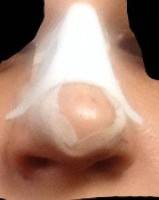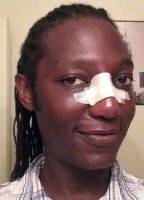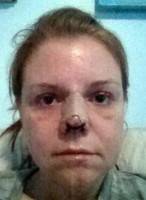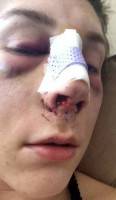Rhinoplasty Recovery After Splint Removal
Recovery for rhinoplasty typically takes two weeks especially if bony work and internal work was done. The acute swelling following a rhinoplasty typically resolves within two weeks.
After that, breathing may be compromised for up to 2 additional weeks and can sometimes take up to two months to return to normal.
The upper and mid third of the nose usually take about 2 weeks for the noticeable swelling to resolve and about 2 months for the additional swelling to disappear.
The lower third and tip area takes the longest to return to normal. Numbness is common for several months and the swelling in the tip can take up to a full year and 18 months in some individuals.
It is important to follow up with your rhinoplasty surgeon for your nose if you have tip work done as sometimes things can occur that can be addressed during the healing process. (Scott Trimas, MD, Jacksonville Facial Plastic Surgeon)
What to expect with a rhinoplasty recovery
I simply tell patients to avoid looking in the mirror for a few days. A lightweight cast is applied to the top of the nose to keep the cartilage and bone in place during healing, and gauze packing is inserted in the nose for one to two days to protect the septum from moving and to minimize bleeding.
While I’ve known patients who have felt perfectly comfortable dining out at restaurants when wearing the cast, most people go into hiding for a few days while the bruising and swelling subside. The post-op feeling is generally not painful, just uncomfortable.
You will want to apply ice and elevate the head, and after a week, the cast comes off. Despite the swelling and bruising, the results are immediate. (Michelle Copeland, MD, DMD, Fort Myers Facial Plastic Surgeon)
Nose job recovery less difficult than you may think
Most surgeons have a specific aftercare program for their patients, which works in their hands. I concur with the general sentiment that Rhinoplasty recovery is rarely painful.
However, it is important to remember that some rhinoplasties are relatively simple, others more complex, and recovery is related to the complexity of the procedure. For example, if septoplasty and/or spreader grafts are required in addition to cosmetic rhinoplasty, some degree of nasal stuffiness will be present for up to several weeks post procedure.
If extensive tip work is required and/or the procedure is a revision case, the nasal tip is likely to be swollen for a longer period of time. In my practice, patients generally have paper tape and a fiberglass cast placed on the nasal dorsum for 1 week, followed by brown paper tape on the dorsum for the second week.
A form of non stick folded gauze (Telfa) is generally placed in the nostrils overnight. This slides out easily the next day and generates a feeling which is akin to eating ice cream too quickly. When the tape is removed from the dorsum at 2 weeks, there is moderate general swelling which is noted. I inform patients that the “final result” with rhinoplasty takes a year and sometimes more to evolve.
A skinny pinched perfect nasal tip at 2 weeks is invariably not perfect at 1 year. Since rhinoplasty philosophy and techniques have evolved to become more constructive and less destructive, the healing process lends itself to incremental decreases in swelling.
When an open approach is utilized, small sutures are removed from the columella (skin bridge between nostrils) at 1 week. Bruising is a variable which can be present or absence depending on patient factors, utilization of osteotomies (breaking nasal bones), and length of the procedure. Osteotomies are tremendously technique dependent and there is a vast difference in postoperative swelling between surgeons who are experienced with the and those who are not. (Stephen Prendiville, MD, Beverly Hills Plastic Surgeon)
Rhinoplasty Swelling and Recovery
Recovery for rhinoplasty varies between patients based on a few key factors:
- the approach used (open vs. closed);
- the work that is done (tip only vs. tip and bridge);
- your specific skin type and healing ability.
Generally speaking, a significant amount of the swelling goes away in the first two weeks. The rest can take a few months, and subtle changes will take place up to a year out. In terms of the immediate post-operative period, most patients feel like their nose is “stuffed up” and report a mild headache. In cases where there was a functional issue with the breathing, the improvement in the airflow may be obvious to the patient even during this early phase. Significant pain or tenderness to the touch should be reported to your surgeon, as this is unusual and could be a sign of infection. Lastly, patients often have some numbness of the tip of the nose and the middle of the upper lip. This generally goes away over time, but can take a couple months. (Evan Ransom, MD, Bay Area Facial Plastic Surgeon)
It usually takes 2-3 weeks to recover from a rhinoplasty. A nasal splint is placed and worn for about a week after surgery. If an open rhinoplasty is performed, sutures are usually removed within 1 week. Residual bruising lasts for about 2 weeks. Residual swelling may last months, but the majority will go down after 2-3 weeks. (Steven Wallach, MD, Manhattan Plastic Surgeon)
This is what I say to patients each and every day:
- 7-10 days for bruising and obvious swelling to go down
- one month to start to see the changes
- Three months to 70% healed
- 12 months to be 100% healed (Benjamin C. Marcus, MD, Madison Facial Plastic Surgeon)
Rhinoplasty Recovery After Splint Removal
Splints and stitches out a one week, swelling still present for 6 weeks to 12 months. Depending on what work you do, might go back after a week.
Of course if you are working outdoors or in a “dirty” environment, it might be longer. (Jeffrey Ditesheim, MD, FACS, Charlotte Plastic Surgeon)
Recovering after Rhinoplasty Surgery
Downtime after rhinoplasty is variable. Most of the healing occurs within the first week, in terms of any discomfort. Generally, patients are back to work/school in about 7-10 days.
Bandages and stitches come off about a week after surgery. You may wash the nose once the cast comes off. Eye glasses may be worn after a couple weeks.
Heavy activity, such as exercise or sex, is allowed after a couple weeks. Contact sports are permitted after about 2 months.
The “final” results may take months or a year to appreciate. Recovery time from rhinoplasty surgery occurs both on the outside and inside of the nose.
Patients are generally “restaurant ready” and socially acceptable within 2 weeks following surgery. Most swelling after rhinoplasty resolves within a month.
The final 20% of swelling takes a much longer time to resolve, up to a year after surgery. Fortunately, this final swelling is usually only evident to the surgeon and patient.
Cosmetic surgery patients may help reduce post-treatment swelling via a variety of methods.
Other potential helpful factors which may help with postop cosmetic surgery swelling include the following reduce salt intakereduce ingesting processed foods and focus on fresh fruits & vegetablesreduce spicy foodsoral diuretic to help urinate excess salt, only for a brief durationsteroid injection or pillshyaluronidasefacial massage or gentile compression dressing to the areaarnica montana tablets. (Houtan Chaboki, MD, Washington DC Facial Plastic Surgeon)
We remove the splint at the 4th day after surgery. Most swelling and bruising should be gone 10th day and it could take up to a year to see the final result. (Jhonny Salomon, MD, Miami Plastic Surgeon)
Unfortunately there is not set answer for the recovery rate and how your body will react to the procedure. Some patient’s experience severe swelling and bruising and others may have minimal to none. Additionally, the recovery time from rhinoplasty surgery is typically not a painful one, which can be quite a pleasant surprise. Immediately after the completion of surgery, a cast it placed on your nose for about 7 days.
During those days and over the consequent weeks, it is recommended to take it easy. However, don’t feel like you are bed ridden, just avoid strenuous activity or severely crowded places. After the removal of the cast, you may see bruising and swelling, that will go down with time. Regular activities can be resumed about three weeks after surgery, with discretion! Always check with your surgeon to your specific restrictions. (Yael Halaas, MD, Manhattan Facial Plastic Surgeon)
Rhinoplasty Recovery Process
Typically, bandages and splints can come off within five to seven days after your surgery. Rhinoplasty swelling can last up to several weeks after which you can resume full activity.
Swelling and pain can be lessened with medication or using cold compresses and this will help with inflammation. Depending on how you are healing, it may take between several days or weeks before you can resume full activity. (Carlo Honrado, MD, FACS, Los Angeles Facial Plastic Surgeon)
Recovery time after a nose job / rhinoplasty
So there is the immediate recovery which is about a week. At your first visit your splint, tape and stitches are removed. Now your nose will Definitely be swollen but you will already be able to see some of your results. You can return to work the next day. Often I will tape the nose for a few days to weeks depending on the degree of swelling you have in order to help with the recovery.
The second phase of healing takes around 4-6wks. By then about 80% of your swelling has resolved and most people wont know you had anything done. The final stage takes up to a year. This is when the last 20% of swelling gradually resolves. There are different things you can do like taping and injections which can accelerate your recovery time from rhinoplasty surgery. (Rady Rahban, MD, Los Angeles Plastic Surgeon)
Post-nose surgery Down TIme
I define downtime as the time that you are really “down.” That means the immediate post-operative recovery time. Post-nose surgery patients stay in our facility for at least an hour and then are discharged to home.
There is a plastic cast placed at surgery to support the reset nasal bones. There is no intranasal packing unless a septoplasty is performed at the same time.
Patients are recommended to rest with ice or bags of frozen peas over their eyes for the next 24 hours. The immediate attention to post-operative icing has certainly decreased the overall post-operative swelling time.
By 48 hours after surgery, patients feel much better. There is minimal to no pain only a feeling of congestion and fullness over the middle face.
The cast is not uncomfortable but it is bulky. Patients are refrained from wearing their reading glasses. By the third day they can often drive a car and perform deskwork activities.
Full physical activities are not recommended for one month following nose surgery. With the cast on, the patients are advised not to shower and get their casts wet.
The cast comes off in one week. The face or perinasal region is often swollen and a bit black and blue and often yellow tinged. This abates by 10 days.
Patients feel to be “themselves” by post-operative day 4. About 80% of the swelling is down by 30 days. By 60 days, 80% of that.
By 6 months there is probably between 10 to 15% swelling still remaining. I explain that often it takes up to a year for the nose to heal. Open nose surgery healing times are a little longer. Most patients I feel are “healed” by 7 months. (Jonathan Berman, MD, Boca Raton Plastic Surgeon)
A typical nose surgery recovery is about a week. There usually is not significant pain or discomfort. One can have swelling and sometimes bruising, but that depends on the patient’s bruising tendencies.
We also make sure our patients stop taking all Aspirin and Fish Oil supplements as they can cause increase in bruising. A patient can also minimize bruising by keeping their head elevated and applying cool compresses to the eyes for the first several days after surgery. The recovery is usually about a week and at that time all the splints and sutures are removed. Then, they can return to work and begin most physical activity within 2-3 weeks. (Rod J. Rohrich, MD, Dallas Plastic Surgeon)
Nose surgery healing time
For most patients the first week after surgery has the most impact upon them. Usually you are wearing an external nasal splint, you may have some internal nasal packing, you will not be able to breathe out of your nose well due to internal swelling and you are likely to have some bruising around the eyes.
Pain is usually not significant – but can be managed with narcotic analgesics as needed. When the spint comes off at the one week visit the nose will usually look better than it did before surgery – even with the post operative swelling.
Bruising usually takes up to two weeks to disappear. Facial and nasal swellilng will continue to resolve for many months and the final result can take up to a year after surgery. Most patients back off of aerobic or strenuous activities for 2-4 weeks at which time they can gradually increase intensity.
Going back to work depends upon your job and how much you are willing to share with your co-workers.
I’ve had patients return to work in as little as 3 days – with the splint on, while others hide out for two weeks. Your surgeon can help give you realistic expectations about most of these issues. (Jon F. Harrell, DO, Miami Plastic Surgeon)
Most patients go back to work usually within a week from their rhinoplasty or nose job. Nasal splints are removed at one week and patients continue to massage their nose for at least 6 weeks in order to help reduce post-operative swelling. (S. Sean Younai, MD, FACS, Beverly Hills Plastic Surgeon)



